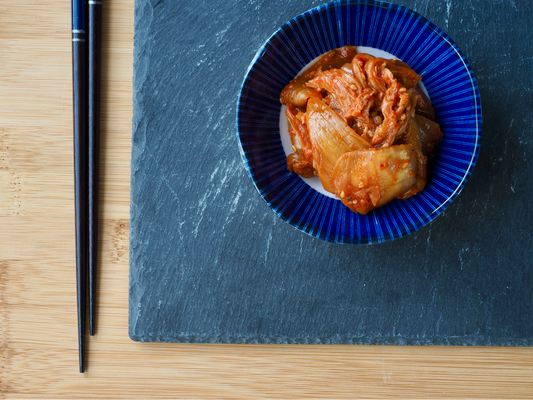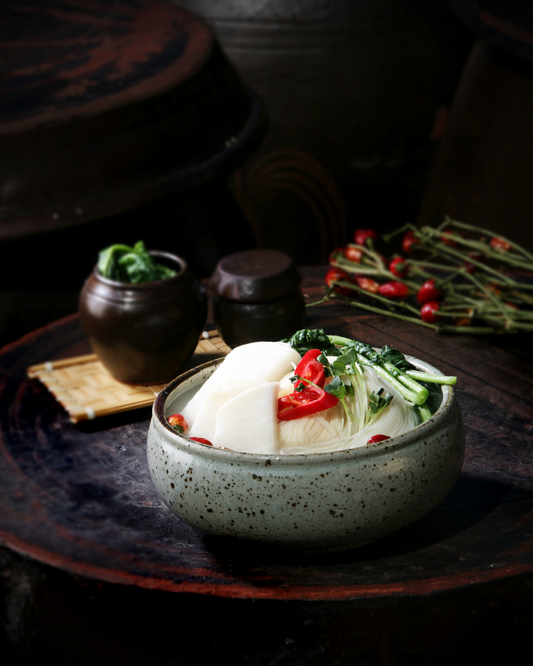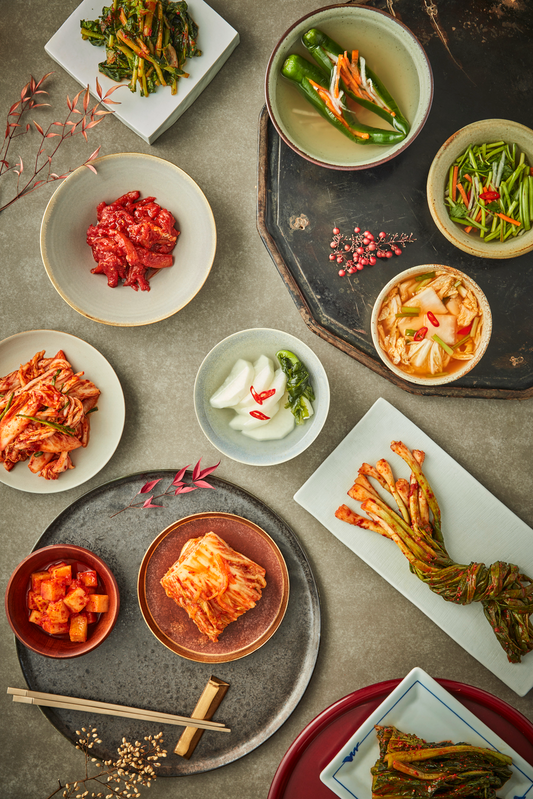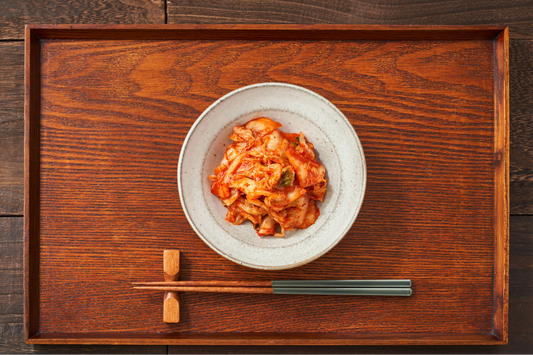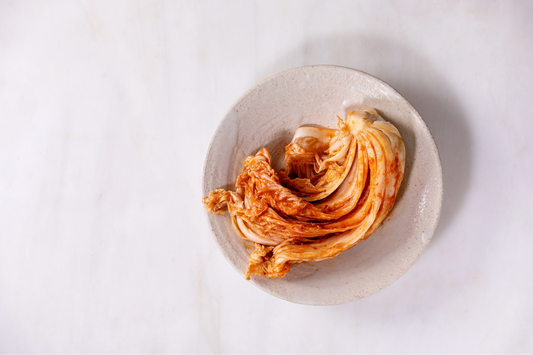Ever wondered how a simple bowl of noodles can show the complexities of society? Or how adding one ingredient can change how we see a culture's food? The Korean movie 'Parasite', directed by Bong Joon Ho, did more than just tell an exciting story. It showed us Korean food culture along with a deep look into society. The dishes jjapaguri and green onion kimchi aren't just food. They symbolize much more within the movie 'Parasite'.
Mixing cheap instant noodles with expensive Korean Hanwoo beef shows the gap between the rich and poor in the film. Green onion kimchi brings in tradition and toughness. These foods take us through the social divides, making us think deeper about the food in 'Parasite' and its cultural significance.
Key Takeaways
- Jjapaguri, also known as Ram-Don, has become a global sensation, reflecting its importance in the celebrated film.
- Exploring the societal meanings behind food in 'Parasite' helps us connect more with Korean culture.
- The rich addition to a basic dish is a food metaphor for class dreams and the mix in modern Korean food culture.
- The careful making of key moments in 'Parasite' shows the precision that also goes into Korean cooking.
- Looking at jjapaguri with traditional sides like green onion kimchi shows Korean flavors' flexibility and energy.
- The effect of 'Parasite' on how certain foods are seen and priced worldwide shows the power of media.

Jjapaguri in Parasite: The symbolism of the scene.
The film 'Parasite' uses Jjapaguri to show a deep message about class conflict. It highlights the gap between the rich and the poor. Class symbolism of Jjapaguri turns a simple dish into a powerful symbol of the struggle and dreams shown in the movie.
The Appearance of Jjapaguri: The reason why jjapaguri appears in a significant scene in the movie
Jjapaguri combines two instant noodles and represents common food in Korea. It appears at the rich Park family's dining table. Director Bong Joon Ho uses this to show a food that crosses class lines but in a way that reflects bigger societal gaps.
Meeting of Luxury Ingredients and Common Food: The meaning of jjapaguri made with premium Korean beef (hanwoo)
The key scene adds Hanwoo beef to Jjapaguri, showing economic inequality. This action turns a simple dish into luxury, using Hanwoo beef, which costs more than other beef. It shows the desire to move up socially, but also the blurry lines between social classes.
Jjapaguri Representing Class Conflict: The class-related symbolism of Jjapaguri in the movie
By adding expensive beef to Jjapaguri in 'Parasite', the dish becomes a sign of longing and inequality. It was a meal for those with less, but now faces the world of the wealthy. This dish shows the clash between different economic worlds in a visually striking way, pointing out the complex nature of class conflict.
What is Jjapaguri?
Jjapaguri comes from Korean cuisine. It mixes the flavors of two popular instant noodles: Chapagetti and Neoguri. This dish shows how simple food can become a gourmet experience. It became famous worldwide after appearing in the movie 'Parasite'. But what makes Jjapaguri stand out, and why does it inspire people in kitchens everywhere?

Origin of Jjapaguri
Jjapaguri started with the creativity of Korean food lovers. It combines Chapagetti's sweet black bean sauce with Neoguri's spicy seafood broth. First a fun idea among noodle fans, it quickly became a Korean cultural icon. It shows how Korean food blends tradition with modern tastes, reaching beyond Korea.
Jjapaguri Recipe
To make Jjapaguri, first boil the noodles and flavor packets. Keep some Neoguri seasoning aside to control the spice. While the noodles cook, fry up some protein like sirloin or even deli meats. Save a cup of the noodle water. This water helps mix the sauces together well.
Then, mix everything, adding the protein and green onions for crunch. This Jjapaguri recipe is simple but has a rich taste. It combines sweet, savory, and spicy flavors. You can adjust it to your liking.
Jjapaguri mixes simplicity with luxury in food. It shows how you can change basic dishes in creative ways. With options to make it cheap or fancy, Jjapaguri appeals to many. It reflects the changing world of food culture.

Green Onion Kimchi: A perfect pairing with jjapaguri.
The mix of green onion kimchi and jjapaguri blends traditional Korean flavors. It makes eating not just enjoyable but also a learning experience. By understanding the tradition of green onion kimchi, its fit with ramen, and the benefits for taste and health, diners can deeply appreciate their meals.
History and Tradition of Green Onion Kimchi
The creation of green onion kimchi came from needing to keep veggies during Korea's cold winters. With green onions as a key part of their diet, Koreans made a kimchi that's both crisp and sharp. This kimchi goes well with many dishes, including the new-age jjapaguri.
Harmony of Green Onion Kimchi with Ramen
Green onion kimchi and ramen together show how different tastes can balance perfectly. When added to jjapaguri, green onion kimchi cuts the dish’s richness. It adds freshness. This mix shows Korean cuisine's ability to create balanced dishes, where each ingredient has a purpose.
Taste and Health Benefits of Green Onion Kimchi
Looking into the taste and health benefits of green onion kimchi shows it’s more than a side dish. Its zesty flavor lifts up the soft noodles and meat in jjapaguri. This kimchi is also packed with vitamins A and C, probiotics, and antioxidants. It's great for taste and health.
Combining jjapaguri with green onion kimchi does more than excite the taste buds. It leads diners into Korea's rich culinary history. Every bite reflects traditions that have been perfected over generations, catering to both classic and modern preferences.
Symbolic Meaning of Jjapaguri and Green Onion Kimchi
Exploring Korean cuisine uncovers a world of rich flavors and cultural symbols. These elements shine in movies like 'Parasite'. Jjapaguri has been popular for four decades, with 9.1 billion units sold. When mixed with Korea's top beef, hanwoo, it becomes more than a regular dish. It bridges social gaps, echoing the themes of class conflict seen in 'Parasite'.

Transformation of Common Food
Jjapaguri is more than a meal within Korean culture; adding hanwoo beef elevates it to a social critique. This combination symbolizes the blending of economic classes within Korean society. As Nongshim works on making this dish global, its evolution from simple to luxurious reflects a growing love for Korean food worldwide, especially in places like Koreatown in Los Angeles.
Green onion kimchi, with its bold flavor and health benefits, also holds deep cultural symbolism. It tells stories of endurance and change through its many variations, like Chonggak-kimchi and Tongbaechu-kimchi. Paired with jjapaguri, it exemplifies the richness of Korean culture. This combination celebrates Korea's legacy while adapting to the modern world's tastes.
FAQ
What is the symbolism of jjapaguri in the movie 'Parasite'?
In 'Parasite', jjapaguri shows how different social classes mix. It takes cheap noodles and mixes them with expensive beef. This mix shows the poor wanting to live like the wealthy. It's about class differences and wanting a better life.
Why does jjapaguri appear in a significant scene in 'Parasite'?
Jjapaguri is used to show the gap between rich and poor in a key scene. The rich family enjoys it with quality beef, unlike the Kim family. This highlights the wealth gap and the rich family's unaware privilege.
How is jjapaguri with premium Korean beef (hanwoo) symbolic?
Adding Hanwoo beef to jjapaguri shows how luxury changes normal items. It mirrors the Kim family trying to seem rich. It highlights the big class gap in the movie.
What does jjapaguri represent in terms of class conflict?
Jjapaguri shows the fight between rich and poor. It's a simple dish made fancy with expensive beef. This act shows how the rich take over simple joys of the poor, showing deep class issues.
Where did jjapaguri originate from?
Jjapaguri, or ram-don, came from South Korea. It mixes Chapagetti and Neoguri instant noodles. After 'Parasite', it gained worldwide fame. It shows how instant noodles are seen in Korean culture.
What's a simple recipe for making jjapaguri at home?
For homemade jjapaguri, start with Chapagetti and Neoguri noodles. Cook and mix them with their seasonings. Add beef slices and green onions for an authentic taste. It's best with Hanwoo beef, like in 'Parasite'.
What is the history and tradition of green onion kimchi?
Green onion kimchi, or Pa kimchi, is a key dish in Korea. It uses fermented green onions with spices. This dish is known for its health perks and deep cultural significance.
Why do jjapaguri and green onion kimchi go well together?
Jjapaguri and green onion kimchi match well because they balance each other. The kimchi's bold taste complements the noodles' richness. It leads to a meal full of different tastes and textures.
What are the taste characteristics and health benefits of green onion kimchi?
Green onion kimchi is spicy, tangy, and a bit sweet. It's full of vitamins, antioxidants, and good bacteria. Fermenting it boosts these health benefits, making it a great food choice.
Why are luxury ingredients added to jjapaguri, and what does it symbolize?
Luxury items in jjapaguri comment on social class desires. It blurs social lines and shows how the poor want to live like the rich. Turning a simple meal luxurious criticizes classism and social divides.




